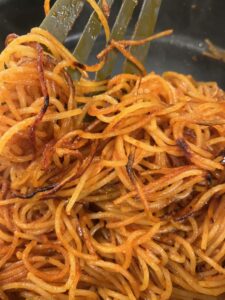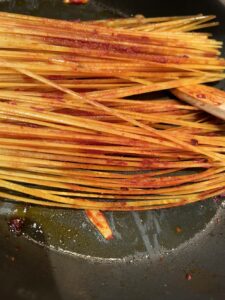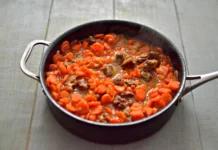
Keri White
Spaghetti all’Assassina translates to “assassin’s spaghetti.” It is also known as “spaghetti bruciati” or “burnt spaghetti” and originates in the city of Bari in the Puglia region in the heel of the Italian boot.
The origins of the dish are murky. Some say it was created in a bar in Bari when two patrons from out of town requested a unique dish, and the chef created it on the fly. When asked, the diners kvelled over the dish and called the chef “a killer” in praise of his culinary skill.
Other sources claim the dish was a mistake, left to burn when the chef was distracted by a beautiful woman. Still others claim the name reflects the dish’s spiciness due to the addition of a healthy dose of crushed red pepper.
I had seen versions of this dish floating all over social media in recent months and, never having met a pasta I didn’t like, decided to give it a whirl. The technique is very different from traditional pasta — for all’assassina, a hot skillet is lined with of a thin layer of tomato paste that is scorched to a caramelized state. Then, dry pasta is added to the skillet and turned over as it begins to brown.
Following that, hot tomato broth is added in portions, similar to the old-school way of making risotto, and the pasta cooks (and chars a bit) over 20 minutes. The pasta is served very al dente — with a firmer “bite” than most other pasta dishes.
My husband recently had a milestone birthday, and he adores this dish. He is in good company; spaghetti all’Assassina has a bit of a cult following. There are actually two competing academies in Bari dedicated to the preservation, optimization and promotion of this cherished local dish.
But I have a confession: In my book, to use the South Philly Italian vernacular, “The juice ain’t worth the squeeze.” My style of cooking aims to achieve the most flavor and deliciousness with the least effort. This dish, while admittedly unique, does not beat a well-cooked al dente pasta topped with really good marinara sauce — certainly not enough to justify the fussiness it requires. But it was his birthday and, I admit, I may be in the minority, so for that reason, I share the recipe here:

Spaghetti all’Assassina | Pareve (or dairy if cheese is added)
Serves 4
Traditionalists use a cast-iron skillet for this dish; I used a large, nonstick skillet.
2½ cups tomato sauce
¼ cup olive oil
2 teaspoons crushed red pepper flakes
3 cloves garlic
¼ teaspoon salt
2 teaspoons tomato paste
2½ cups water
1 cup red wine
1 pound dried spaghetti
1 bunch chopped fresh parsley
⅓ cup grated Parmesan cheese (optional)
Heat a tablespoon of oil in a saucepan. Slice a clove of garlic and add it to the pan. Stir until fragrant and add the tomato sauce, water and wine.
Heat it to a simmer and keep it warm. Slice the remaining 2 cloves of garlic. In a large skillet, heat the remaining oil and add the garlic, red pepper flakes and salt. Sauté until fragrant.
Add the tomato paste, spread it over the bottom of the pan and heat it over medium to medium-high. When the paste begins to caramelize, scrape the bottom of the pan and add the spaghetti. Add a small amount of tomato broth to prevent the spaghetti from sticking to the pan.
Allow the pasta to toast and turn it over. Add 1 cup of hot tomato broth and stir until it’s absorbed. The pasta will begin to soften. Repeat this step, a cup at a time, until all the broth is used. The pasta should be slightly brown/charred in some areas and should retain a firm bite — almost a crunch.
Serve topped with fresh parsley and cheese, if desired.
Keri White is a Philadelphia-based food writer.






